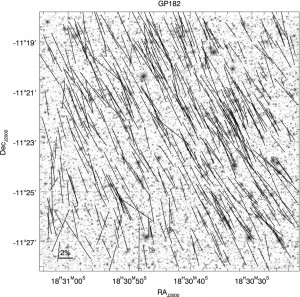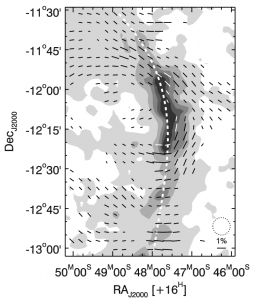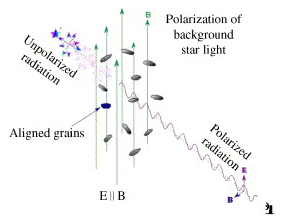How are molecular clouds influenced by the presence of magnetic fields? Do magnetic fields affect cloud collapse and morphology? Before stars form, it is necessary to form molecular clouds and dense cores in the clouds, but these processes are still not well understood.
My research seeks to determine the role of magnetic fields in the formation of molecular clouds by observing the direction of the magnetic field in a large sample of molecular clouds. Strong, weak, and helical magnetic field models predict distinct magnetic field morphologies, which can be probed though near-infrared (NIR) polarization of background starlight.
In the presence of a magnetic field, spinning asymmetric dust grains become aligned with their long axis preferentially perpendicular to the field. As background (unpolarized) starlight passes through clouds containing these dust grains, it sees a larger extinction parallel to the long axis of the grains (dichroic extinction) and thus picks up a small amount of polarization parallel to the magnetic field direction. This linear polarization can be measured and reveals the magnetic field orientation, projected onto the plane of the sky.
 I observe these NIR polarizations with the Mimir instrument on the Perkins 1.8m telescope outside of Flagstaff, AZ. In addition to conducting pointed observations of individual clouds, I have also helped with observations and data reduction for the Galactic Plane Infrared Polarization Survey (GPIPS, link at right). GPIPS was designed to probe the magnetic field in the cool, star-forming interstellar medium. This Survey covered a 76 sq deg region of the Galactic plane, from l = 18° to 56° and |b| ≤ 1°. It was designed to reach regions of low to moderate extinction (2 ≤ Av ≤ 20 mags) and probe the B-fields of molecular clouds, both star-forming and quiescent. All GPIPS fields have been observed and the reduced data are now publicly available via the GPIPS website.
I observe these NIR polarizations with the Mimir instrument on the Perkins 1.8m telescope outside of Flagstaff, AZ. In addition to conducting pointed observations of individual clouds, I have also helped with observations and data reduction for the Galactic Plane Infrared Polarization Survey (GPIPS, link at right). GPIPS was designed to probe the magnetic field in the cool, star-forming interstellar medium. This Survey covered a 76 sq deg region of the Galactic plane, from l = 18° to 56° and |b| ≤ 1°. It was designed to reach regions of low to moderate extinction (2 ≤ Av ≤ 20 mags) and probe the B-fields of molecular clouds, both star-forming and quiescent. All GPIPS fields have been observed and the reduced data are now publicly available via the GPIPS website.
 Though not all measured stellar polarizations have high enough signal-to-noise to individually trace the magnetic field, all of the polarizations are useful. Lower signal-to-noise polarizations can be combined spatiall, using weighted means, to produce smoothed polarization maps. The figure to the left is a magnetic field map of dark cloud L204. The background image is an extinction map of L204 and the black vectors represent the polarization percentages P and position angle PAs. The dotted black circle in the lower right shows the effective FWHM of the polarization map.
Though not all measured stellar polarizations have high enough signal-to-noise to individually trace the magnetic field, all of the polarizations are useful. Lower signal-to-noise polarizations can be combined spatiall, using weighted means, to produce smoothed polarization maps. The figure to the left is a magnetic field map of dark cloud L204. The background image is an extinction map of L204 and the black vectors represent the polarization percentages P and position angle PAs. The dotted black circle in the lower right shows the effective FWHM of the polarization map.
 I am currently analyzing H and K-band polarization data of the Integral-Shaped Filament (ISF) in the Orion Molecular Cloud. Past studies have suggested that ISF’s filamentary structure is supported by helical magnetic fields, so I am looking for the presence (or absence) of a helical field structure. To the right is a sneak peek at the K-band polarizations spanning the entire ISF. Come by my poster at the Summer AAS meeting in Boston this June to find out more.
I am currently analyzing H and K-band polarization data of the Integral-Shaped Filament (ISF) in the Orion Molecular Cloud. Past studies have suggested that ISF’s filamentary structure is supported by helical magnetic fields, so I am looking for the presence (or absence) of a helical field structure. To the right is a sneak peek at the K-band polarizations spanning the entire ISF. Come by my poster at the Summer AAS meeting in Boston this June to find out more.
